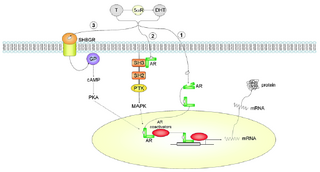Angaben zur Quelle [Bearbeiten]
| Autor | C. D. Foradori, M. J. Weiser, and R. J. Handa |
| Titel | Non-genomic Actions of Androgens |
| Zeitschrift | Front Neuroendocrinology |
| Datum | May 2008 |
| Seiten | 169–181 |
| Anmerkung | For the documentation the page numbers of the linked PDF file are used. |
| URL | http://www.ncbi.nlm.nih.gov/pmc/articles/PMC2386261/ |
Literaturverz. |
ja |
| Fußnoten | ja |
| Fragmente | 3 |
| [1.] Shg/Fragment 012 21 - Diskussion Zuletzt bearbeitet: 2014-11-03 14:52:25 Hindemith | Foradori et al 2008, Fragment, Gesichtet, SMWFragment, Schutzlevel sysop, Shg, Verschleierung |
|
|
| Untersuchte Arbeit: Seite: 12, Zeilen: 21-25 |
Quelle: Foradori et al 2008 Seite(n): 1, Zeilen: 21ff |
|---|---|
| The classic genomic model for steroid hormone action presumes that steroid hormones can freely cross the Plasma Membrane, enter the cytoplasm, and bind to activate specific iAR. The bound steroid receptors act as transcription factors and bind as homodimers or heterodimers to specific DNA response elements in target gene promoters, causing protein synthesis. [Guido M, Uta C.P. 2008]
Guido M, Uta C.P. (2008). Raptid action of androgens. Neuroendocrinology 29: 182-198. |
This classic genomic model for steroid hormone action presumes that steroid hormones can freely cross the plasma membrane, enter the cytoplasm, and bind to and activate specific intracellular steroid receptor proteins. The bound steroid receptors act as transcription factors and bind as homodimers or heterodimers to specific DNA response elements in target gene promoters, causing activation or repression of transcription and subsequently protein synthesis (Figure 1) [2; 3; 4; 5; 6].
2. Beato M. Gene regulation by steroid hormones. Cell. 1989;56:335–344. [PubMed] 3. Roy AK, Lavrovsky Y, Song CS, Chen S, Jung MH, Velu NK, Bi BY, Chatterjee B. Regulation of androgen action. Vitam Horm. 1999;55:309–352. [PubMed] 4. Heinlein CA, Chang C. Androgen receptor (AR) coregulators: an overview. Endocr Rev. 2002;23:175–200. [PubMed] 5. Zhou ZX, Wong CI, Sar M, Wilson EM. The androgen receptor: an overview. Recent Prog Horm Res. 1994;49:249–274. [PubMed] 6. Quigley CA, De Bellis A, Marschke KB, el-Awady MK, Wilson EM, French FS. Androgen receptor defects: historical, clinical, and molecular perspectives. Endocr Rev. 1995;16:271–321. [PubMed] |
Ein Verweis auf die Quelle fehlt. Die angegebene Quelle enthält die Passage nicht. Man beachte dass mit "Guido M, Uta C.P. (2008). Raptid action of androgens. Neuroendocrinology 29: 182-198." wohl "Guido Michels, Uta C. Hoppe (2008). Rapid actions of androgens. Frontiers in Neuroendocrinology 29 (2008) 182–198" gemeint ist. |
|
| [2.] Shg/Fragment 013 08 - Diskussion Zuletzt bearbeitet: 2014-12-13 20:28:19 Hindemith | Foradori et al 2008, Fragment, Gesichtet, SMWFragment, Schutzlevel sysop, Shg, Verschleierung |
|
|
The source is not mentioned here. The figures are not 100% identical, but clearly not independent either. |
|
| [3.] Shg/Fragment 015 01 - Diskussion Zuletzt bearbeitet: 2014-10-29 18:44:33 Kybot | BauernOpfer, Foradori et al 2008, Fragment, SMWFragment, Schutzlevel, Shg, ZuSichten |
|
|
| Untersuchte Arbeit: Seite: 15, Zeilen: 1-15 |
Quelle: Foradori et al 2008 Seite(n): 0, Zeilen: 0 |
|---|---|
| [It has to take the additional time for] mRNA to be translated into proteins and for those proteins to be processed and induce measurable responses. The cellular responses are changes in free intracellular calcium, and activations of second messenger pathways. The second criterion is membrane mediated. The response should include embedding membrane or associating receptors or binding proteins. The action can be induced even when the steroid is conjugated to molecules which prohibit it from translocation to the nucleus when bound to a receptor. The most common example is the use of testosterone (T) conjugated to large molecules such as bovine serum albumin (BSA). The last is lacking transcription/ translation machinery activation. Experiments using cell lines either lacking the necessary machinery for a genomic response or identifying androgen effects, they are insensitive to inhibitors of transcription and translation. All this demonstrated that certain steroid responses can be elicited in systems where gene transcription or protein synthesis is was unlikely or impossible. [C.D.Foradori, et al. 2008] | However, it then takes additional time for mRNA to be translated into proteins and for the proteins to be processed and induce measurable responses. Typically, cellular responses, which meet this requirement, are changes in free intracellular calcium, and activation of second messenger pathways. 2) Membrane mediated: the response may involve membrane embedded or associated receptors or binding proteins, and with an action that can be induced even when the steroid is conjugated to molecules that prohibit it from entering deep into the cytoplasm or from translocating to the nucleus when bound to a receptor. The most common example is the use of testosterone (T) conjugated to large molecules such as bovine serum albumin (BSA). 3) Lacking transcription/translation machinery activation: experiments using either cell lines that lack the necessary machinery for a genomic response or identify androgen effects which are insensitive to inhibitors of transcription and translation, thereby demonstrate that certain steroid responses can be elicited in systems where gene transcription or protein synthesis is unlikely or impossible. |
might be considered "no verdict" as well since the source is given and it is not a literal copy. |
|

